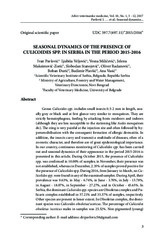Приказ основних података о документу
Seasonal dynamics of the presence of culicoides spp. in Serbia in the period 2015-2016
Sezonska dinamika prisustva culicoides spp u Srbiji u periodu 2015-2016. godine
| dc.creator | Pavlović, Ivan | |
| dc.creator | Veljović, Ljubiša | |
| dc.creator | Milićević, Vesna | |
| dc.creator | Maksimović-Zorić, Jelena | |
| dc.creator | Stanojević, Slobodan | |
| dc.creator | Radanović, Oliver | |
| dc.creator | Đurić, Boban | |
| dc.creator | Plavšić, Budimir | |
| dc.creator | Vasić, Ana | |
| dc.date.accessioned | 2020-12-18T10:40:01Z | |
| dc.date.available | 2020-12-18T10:40:01Z | |
| dc.date.issued | 2019 | |
| dc.identifier.issn | 1820-9955, 2683-4138 | |
| dc.identifier.uri | https://vet-erinar.vet.bg.ac.rs/handle/123456789/1958 | |
| dc.description.abstract | Genus Culicoides spp. includes small insects 0.5-2 mm in length, usually grey or black and at first glance very similar to mosquitoes. They are strictly hematophagous, feeding by attacking hosts outdoors and indoors (although they are less susceptible to the stationing like Aedes mosquitoes do). The sting is very painful at the injection site and often followed by hypersensibilisation with the consequent formation of allergic dermatitis. In addition, the insects carry and transmit a multitude of diseases, often of a zoonotic character, and therefore are of great epidemiological importance. In our country, continuous monitoring of Culicolides spp. has been carried out and seasonal dynamics of their appearance in the period 2015-2016 is presented in this article. During October 2015, the presence of Culicolides spp. was confirmed in 10.00% of samples; in November, their presence was not established, whereas in December, 2.35% of samples proved positive for the presence of Culicolides spp. During 2016, from January to March, no Culicolides spp. were found in any of the examined samples. During April, their prevalence was 9.63%, in May - 6.74%, in June - 3.70%, in July - 15.78%, in August - 18.07%, in September - 27.27%, and in October - 45.65%. In Serbia, the dominant Culicoides spp. species are Obsoletus complex and Pulicaris complex established in 57.21% and 33.37% of samples, respectively. Other species are present in lesser extent. In Obsoletus complex, the dominant species was Culicoides obsoletus/scoticus. The percentage of Culicoides obsoletus /scoticus males in samples was 25.52%. Non-pigmented (young) females were present in 66.06% of samples; females who took blood in 7.55% and 0.87% were gravid females. In Pulicaris complex, the dominant species was Culicoides pulicaris. Males of Culicoides pulicaris were found in 19.23% of samples, non-pigmented (young) females in 70.96%, females who took blood in 9.08% while 0.73% were gravid females. | en |
| dc.description.abstract | Rod Culicoides spp. su mali insekti veličine 0,5-2 mm, većinom sivkaste ili crne boje i na prvi pogled veoma slični komarcima. Oni su striktne hematofage. Ubod je veoma bolan, a mesta uboda su često hipersenzibilisana uz posledično nastajanje alergijskih dermatitisa. Uz to oni prenose mnoštvo oboljenja često zoonotskog karaktera tako da su od izuzetnog epidemiološkog značaja. U našoj zemlji se vrši stalni monitoring Culicolides-a i ovde dajemo prikaz sezonske dinamike njihovog pojavljivanja u periodu 2015-2016.godine. Tokom 2015. godine u oktobru je njihovo prisustvo ustanovljeno u 10.,00% uzoraka, u novembru ih nije bilo, a tokom decembra su bili prisutni u 2,35%. Tokom 2016. godine tokom januara, februara i marta nisu nađeni ni u jednom prispelom uzorku. Tokom aprila meseca njihova prevalencija je iznosila 9,63%, u maju je bila 6,74%, u junu 3,70%, u julu 15,78%, u avgustu 18,07%, u septembru 27,27% i u oktobru 45,65%. U Srbiji su dominantne vrste Culicoides spp. iz Obsoletus kompleksa i ustanovljeni su u 57,21%. Culicoides spp. iz Pulicaris kompleksa ustanovljeni su 33,37% dok su ostale vrste manje zastupljene. Kod Culicoides spp. iz Obsoletus kompleksa dominantna vrsta je bila Culicoides obsoletus/scoticus. Mužjaci su nađeni u 25,52%, nepigmentisane (mlade) ženke u 66,06%, ženke koje su uzele krv u 7,55%, a 0,87% su bile gravidne ženke. Kod Culicoides spp. iz Pulicaris kompleksa dominantna vrsta je bila Culicoides pulicaris. Mužjaci su nađeni u 19,23%, nepigmentisane (mlade) ženke u 70,96%, ženke koje su uzele krv u 9,08%, a 0,73% su bile gravidne ženke. | sr |
| dc.publisher | Scientific Veterinary Institute “Novi Sad”, Novi Sad | |
| dc.rights | openAccess | |
| dc.rights.uri | https://creativecommons.org/licenses/by/4.0/ | |
| dc.source | Archives of Veterinary Medicine | |
| dc.subject | Culicoides spp | |
| dc.subject | Seasonal dynamics | |
| dc.subject | Serbia | |
| dc.subject | sezonska dinamika | |
| dc.subject | Srbija | |
| dc.title | Seasonal dynamics of the presence of culicoides spp. in Serbia in the period 2015-2016 | en |
| dc.title | Sezonska dinamika prisustva culicoides spp u Srbiji u periodu 2015-2016. godine | sr |
| dc.type | article | en |
| dc.rights.license | BY | |
| dcterms.abstract | Ђурић, Бобан; Радановић, Оливер; Милићевић, Весна; Вељовић, Љубиша; Плавшић, Будимир; Васић, Aна; Павловић, Иван; Станојевић, Слободан; Максимовић-Зорић, Јелена; СЕЗОНСКA ДИНAМИКA ПРИСУСТВA ЦУЛИЦОИДЕС СПП. У СРБИЈИ У ПЕРИОДУ 2015-2016. ГОДИНЕ; СЕЗОНСКA ДИНAМИКA ПРИСУСТВA ЦУЛИЦОИДЕС СПП. У СРБИЈИ У ПЕРИОДУ 2015-2016. ГОДИНЕ; | |
| dc.citation.volume | 10 | |
| dc.citation.issue | 1 | |
| dc.identifier.doi | 10.46784/e-avm.v10i1.76 | |
| dc.identifier.fulltext | https://vet-erinar.vet.bg.ac.rs/bitstream/id/5199/Seasonal_dynamics_of_pub_2019.pdf | |
| dc.type.version | publishedVersion |

